Combat
Fatigue Irritability
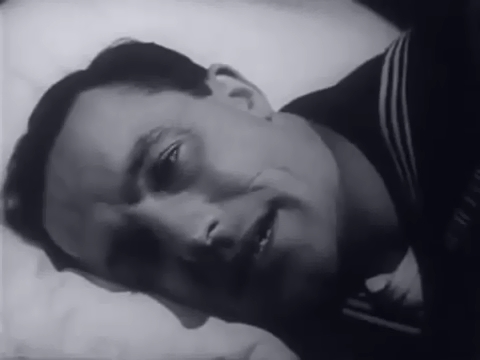
A restricted training film from the U.S. Navy, Bureau of Aeronautics, that might have been seen by Capra at the War Department and treated as a foundation stone for It’s a Wonderful Life the following year.
Invitation
to the Dance
The falling
clown, the wayward wife, the genie of the lamp.
The urge to
dance, the vicious circle, the dance of life.
“Circus”
Barrault and
Nijinsky (Petrushka). Bells on, the attributes of art. The tightrope
walker.
“Ring Around the Rosy”
The Husband gives
the Wife a wristlet, she gives it to the Artist, from him it passes to the
Model and the Sharpie and the Femme Fatale and the Crooner and the Hatcheck
Girl and the Marine and the Girl on the Stairs and back to the Husband, who
hands it to his butler to present to the Wife. The gay social whirl collapses.
“Sinbad the Sailor”
The diamond
dragon quelled by the genie. The palace guards danced into balls. The harem
girl a WAVE, the genie Sinbad, Jr.
The work was
completely misunderstood as a compendium of the dance, which accounts for its
failure.
The scenario is
exceptionally well-conceived, the three parts of “Circus” mirror
the overall structure, “Sinbad the Sailor” is “Ring Around
the Rosy” in reverse (the buying of the bracelet, the buying of the
lamp).
Among the
film’s champions is Robert Stevenson, who studied it very closely or
invented it for Mary Poppins. Andrew Sarris (The American Cinema), “an uneasy mixture of Hollywood
formulas and European pretensions.”
The
Happy Road
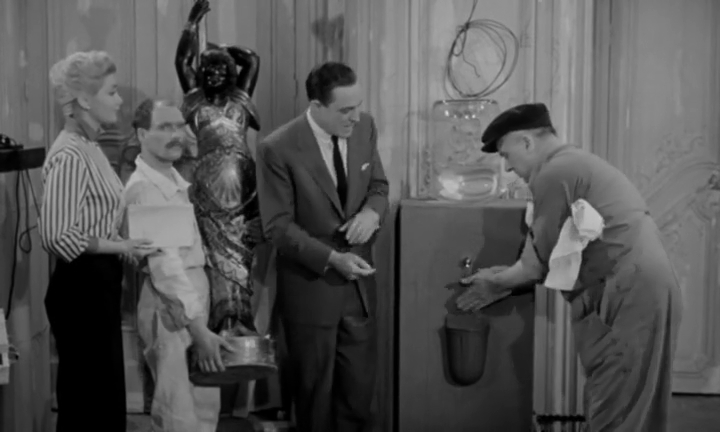
An American in
Paris with the only water cooler replacing a statue in his new Manhattan Mart (cf. Antonioni’s Le Amiche),
“it’s the only place left
for the water cooler...” The younger generation
lams out of Swiss boarding school with, by dint of her tears, a French girl
whose mother is in Paree.
There it is,
Renoir’s window on the countryside in La
Grande illusion, the kid like a young Gene Kelly lets himself down on a
rope into it (he resembles Alfalfa as well, also from Renoir is a sense of the
sublime and the ridiculous at once, or nearly). The
girl is Brigitte Fossey and she speaks English, so
does her mother. Maurice Chevalier sings the title
number.
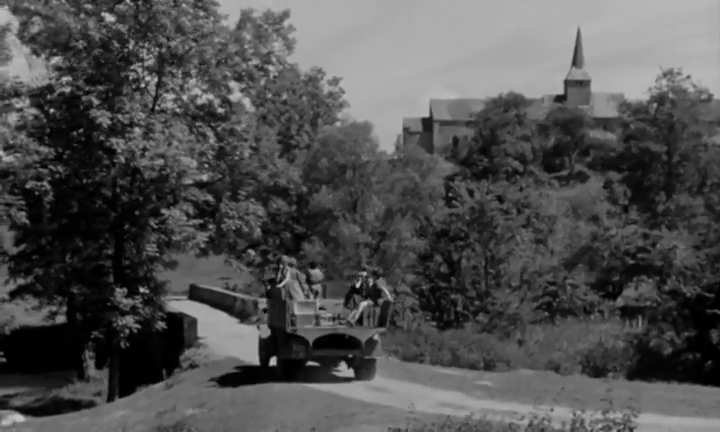
“Smartest
thing I ever did was to send my boy to school up there in Switzerland, I wouldn’t have him in a French school
if they guaranteed me he’d wind up President, the Swiss get things
done!” Kelly has a down-angle on the wee English
earl, a schoolchum and roommate and conspirator, the
reverse shot is a corresponding up-angle, the script finds itself reflected in
Simon Gray’s Butley (dir.
Harold Pinter), “he’s wearing
my socks. My mother always sends me the wrong size, but they fit Danny!” The déjeuner sur l’herbe is picked up by Truffaut in L’Argent de poche (and
there is Malle’s Au revoir les enfants).
A motard de province, “I am in England
when there was the war... cheers, pip-pip, n’est-ce pas,” to which the Yank’s
beamish reply is, “top-hole!” A tale of
the Resistance as une petite bande
(cf. Charles Crichton’s Hue and Cry or Peter Tewksbury’s Emil and the Detectives) and Vigo’s L’Atalante... “What a
way I picked to learn French... you big clod, you couldn’t find your own
nose with both hands, a full moon and radar... Pous-sez! Pous-sez!” Madame is getting married in
Monte Carlo and briefly invents the celebrated Segway
on a truncated motor scooter.
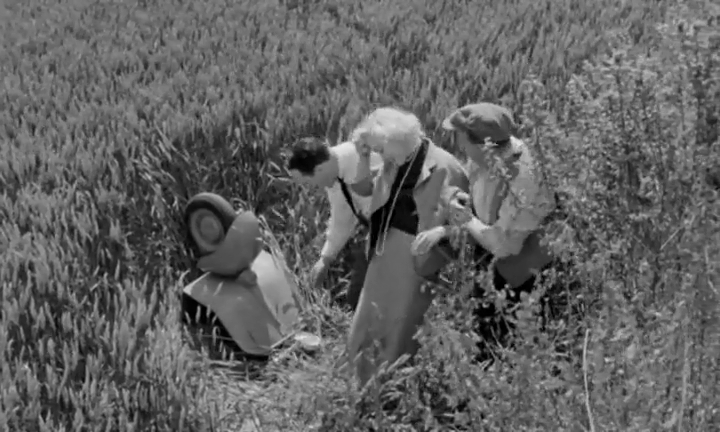
“Manœuvres militaires”
are an impediment (cf. Val
Guest’s The Runaway Bus), the
English commanding general’s batman is a Sgt. Emerson. “Good
man, Armbruster,” aide-de-camp, Major.
For a minute or
so it evokes Jeux interdits
(dir. René Clément), “Operation Meat Loaf... this plan that I’m
activating is one that we had not intended
using until the Red Army was actually
in Trafalgar Square,” cf. Roy & John Boulting’s Seven Days to Noon (“impenetrable
ring of steel”) or for that matter Ken Russell’s Vaughan Williams: A Symphonic Portrait
(tanks and terrain) or Bud Yorkin’s The Thief Who Came to Dinner
(M-1’s exasperation).
The
woodcutter’s caravan pirouettes quite swiftly on Griffith’s Broken Blossoms and is vividly
remembered by Robert Mulligan in To Kill
a Mockingbird, demonstrating a kind of cinematic provenance. An international bicycle race echoes De Sica’s Ladri di biciclette in its give and take of “goodwill”.

Three pairs of
skilled hands turned out the parallel constructions of the screenplay, the
director and principal actor of Combat
Fatigue Irritability draws a lesson on ulcers (cf. Cukor’s The
Marrying Kind) and the inspiration for Gigot
(cf. Truffaut & Godard’s Une Histoire d’eau,
Alexander Mackendrick’s Sammy going
South, George Roy Hill’s A
Little Romance).
Arthur Knight (The Saturday Review),
“hilarious”. Bosley Crowther
of the New York Times,
“strained to the point of juvenile simplicity.” Leonard
Maltin, “minor”. Hal
Erickson (All Movie Guide),
“tends to bludgeon its audience”. Halliwell’s Film Guide, “fails to come off”.
“The charm
and brilliance of Gene Kelly’s dancing has not carried over to his
direction since the dissolution of his partnership with Donen.
If Donen has since diminished, Kelly has completely disintegrated...” (Andrew Sarris, The
American Cinema).
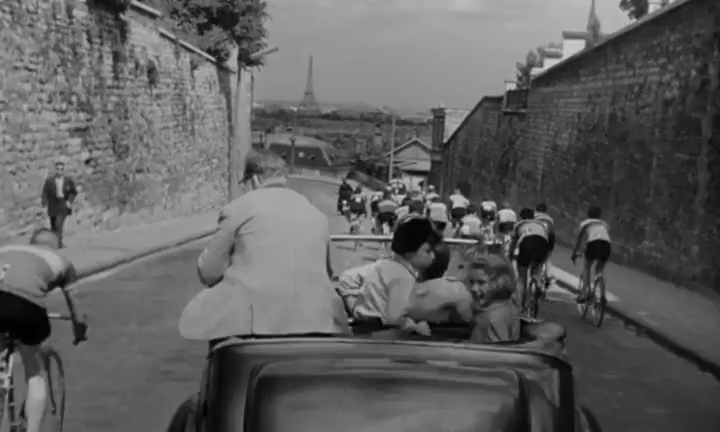
Gigot
As poor as a
poet, as silent as a modern one, and twice as put upon.
The authority for
the work comes from Jackie Gleason, who penned the story fleshed out by John
Patrick, and wrote the music.
Bosley Crowther squirmed,
as well he might. Gigot’s mourners, seeing him alive, forget their
encomiums and pursue him through the streets of Paris once again. Andrew Sarris
(The American Cinema), “pure
slop out of the gutters”.
A Guide for the Married Man
To every loophole,
by a skillful lawyer (Robert Morse), instructing an investment counselor
(Walter Matthau).
An exhaustive
manual of deceit, fraud, treachery and cunning, merely to serve an idle
temptation (the wife is Inger Stevens, and she can cook).
Ebert opined that
it was all “a waste of talent.”
Hello, Dolly!
In the spirit of
Cornelius Hackl, the colossal production is entirely thrown away.
This entails
skilled effort on the part of the director, the choreographer, and the
orchestrators to sink the performers and the music and Thornton Wilder.
The essence of
the thing, then, is all that was sought and achieved. The bet was made for life
and all, a fair one.
The Cheyenne Social Club
Kelly’s
masterpiece on the Old West is a Republican-and-Democrat thing, both Democrats
really.
One inherits a
whorehouse and is a “Republican businessman” for the nonce, in
Bostonian duds.
Both cowpokes,
truth be told.
Rex Reed’s
aphorism was the dullest thing since James Agee stumbled over Wellman’s The
Ox-Bow Incident.
That’s Entertainment, Part II
The authorship of
the film isn’t delineated, Kelly (with Astaire and Cahn) acts Sir Kenneth
Clark in the galleries.
An exaltation of
the muse.